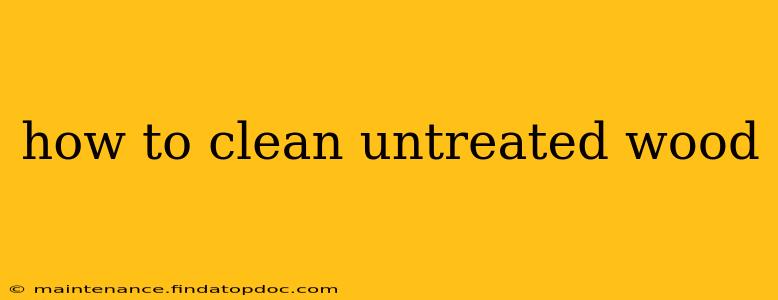Untreated wood, with its natural beauty and rustic charm, adds warmth and character to any space. However, maintaining its pristine condition requires understanding how to clean it properly without damaging the surface. This guide offers a comprehensive approach to cleaning untreated wood, covering various scenarios and providing expert tips to keep your wooden surfaces looking their best.
What are the Different Types of Untreated Wood?
Before diving into cleaning methods, it's crucial to understand the type of untreated wood you're dealing with. Different woods have varying levels of porosity and hardness, influencing the cleaning approach. Common types include pine, cedar, oak, and redwood, each possessing unique characteristics. Knowing your wood type helps you choose the appropriate cleaning method and avoid damage.
How Do I Clean Untreated Wood Furniture?
Cleaning untreated wood furniture depends heavily on the finish (or lack thereof) and the type of dirt or stain.
For Dust and Light Debris:
- Dry Cleaning: Start with a soft-bristled brush or a microfiber cloth to remove loose dust and debris. This is the most gentle method and should be your first step for regular cleaning.
For Spills and Stains:
-
Gentle Cleaning: For sticky spills or light stains, mix a small amount of mild dish soap with warm water. Dip a soft cloth into the solution, wring it out thoroughly (excess water can damage the wood), and gently wipe the affected area. Immediately dry the area with a clean, dry cloth. Never soak the wood.
-
Avoid Harsh Chemicals: Avoid using harsh chemicals like bleach, ammonia, or strong solvents, as these can damage the wood's finish and dull its natural beauty.
-
Test in an Inconspicuous Area: Before applying any cleaning solution to the entire piece, always test it in an inconspicuous area first to ensure it doesn't cause discoloration or damage.
How Do I Clean Untreated Wood Floors?
Untreated wood floors require careful cleaning to avoid scratches and water damage.
-
Regular Sweeping or Vacuuming: Regularly sweep or vacuum your floors to remove dust, dirt, and debris. Use a soft-bristled broom or a vacuum cleaner with a hardwood floor attachment.
-
Damp Mopping (Sparingly): For deeper cleaning, use a damp (not wet) mop. Wring out the mop thoroughly to remove excess water. Use a wood floor cleaner specifically designed for untreated wood, or a solution of mild dish soap and warm water. Always mop with the grain of the wood.
How Often Should I Clean Untreated Wood?
The frequency of cleaning depends on the location and use of the wood. High-traffic areas like floors may require more frequent cleaning than less-used furniture pieces. Generally, dusting should be done regularly, while deeper cleaning can be done as needed, depending on the level of soiling.
What are Some Common Mistakes to Avoid When Cleaning Untreated Wood?
-
Using too much water: Excess water can damage untreated wood, causing warping or discoloration. Always wring out your cleaning cloths or mop thoroughly.
-
Using abrasive cleaners: Harsh chemicals and abrasive cleaners can scratch or damage the wood's surface. Stick to mild, natural cleaners.
-
Leaving the wood wet: Always dry the wood completely after cleaning to prevent water damage.
-
Neglecting regular maintenance: Regular dusting and cleaning prevent the buildup of dirt and grime, which can lead to more significant cleaning challenges later.
Can I Use Vinegar to Clean Untreated Wood?
While vinegar is a natural cleaner, it's generally not recommended for untreated wood. Its acidity can potentially damage the wood over time, especially if used frequently or in concentrated form. Stick to milder, soap-based solutions.
What's the Best Way to Protect Untreated Wood?
Protecting untreated wood is key to its longevity and beauty. Consider using a wood conditioner or a natural oil-based finish to help protect the wood from moisture damage and dirt. Always follow the manufacturer’s instructions when applying any protective finish.
By following these guidelines, you can effectively clean untreated wood while preserving its natural beauty and extending its lifespan. Remember, prevention is key—regular dusting and careful cleaning will significantly reduce the need for more intensive cleaning procedures.
